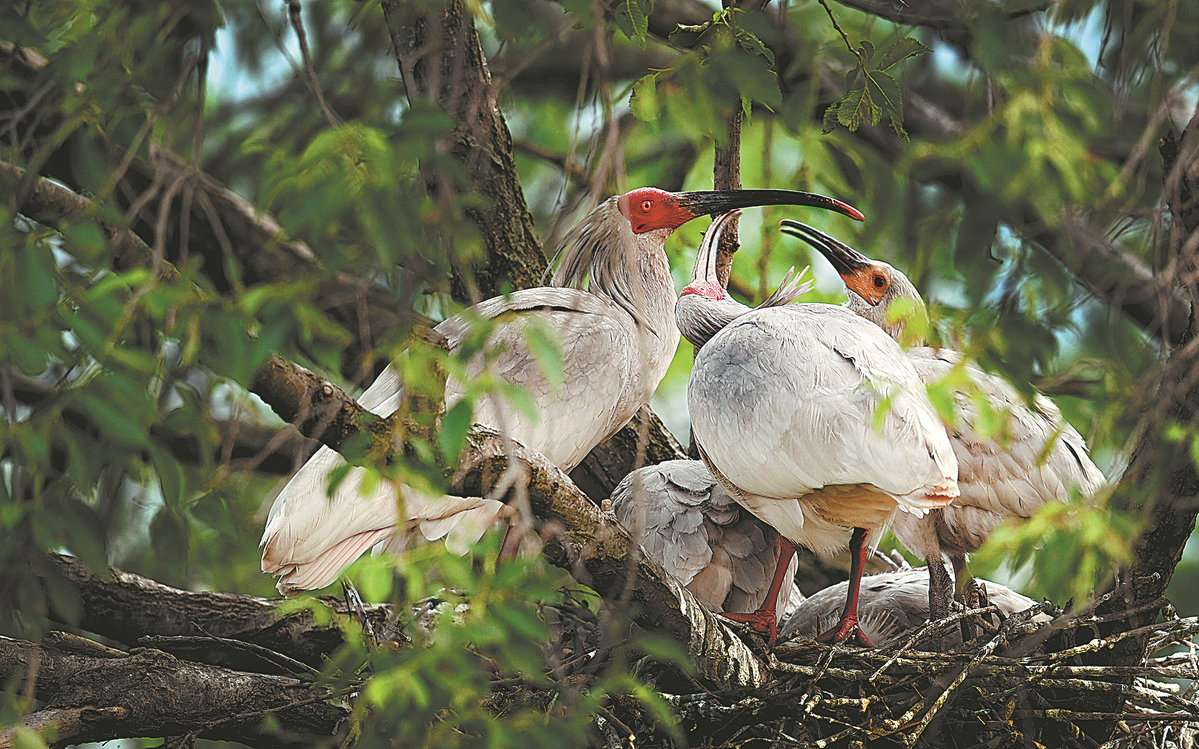Crested ibis makes comeback
 A crested ibis looks after fledglings in Yangxian county, Shaanxi province. [TAO MING/XINHUA]
A crested ibis looks after fledglings in Yangxian county, Shaanxi province. [TAO MING/XINHUA]
Camping in the wild for at least two weeks at a time is normal for Chang Xiuyun. The harsh living conditions she encounters searching for the endangered crested ibis have never held her back.
Chang, 60, a senior specialist at the Shaanxi Forestry Bureau, was attracted decades ago by the grace and beauty of the birds-gems of the treasure trove of nature found deep in the Qinling Mountains. She has devoted her career to saving them.
"The crested ibis is intelligent and makes me feel loved every time I see them," Chang said. Over the past 40 years, she has observed the white-plumed birds with partially bald heads building new nests and communicating their emotions. And she has also seen their numbers surge.
Chang, along with other conservationists, has spent decades working to save the crested ibis from extinction. In some Asian cultures, it is widely believed that the bird brings good luck.
It was thought to have gone extinct in 1981, when what was thought at the time to be world's last seven known birds of the species were spotted in the wilderness of Yangxian county, Shaanxi province.
Yangxian established an observation station in 1983. Three years later, 12 professionals dedicated to safeguarding the ibises were assigned to the area. In 2005, areas into which ibises had frequented became a national nature reserve of nearly 38,000 hectares.
A new blue book released on Tuesday said that as of the end of last year, the crested ibis population in Shaanxi stood at 5,257, accounting for nearly 80 percent of the country's total and about 69 percent of the global total.
"They were rare in the 1980s," Chang said, adding that her first job after graduation in 1983 was to protect injured ibises.
In situ conservation-referring to places, or sites, where the birds live-has been the principle Chang and her team have emphasized over the past 40 years.
In the late 1990s, Chang recalled, captive breeding was attempted. The domestication of the wild creatures required sustained efforts. Chang put the birds into a large net enclosure, allowing them to adjust, mate and lay eggs.
The species has been expanding steadily. In 2002, a strategy was developed to enlarge the habitat of the birds, so that all their eggs were not in one figurative basket. If they vanished from one region of the world, they would be preserved in another.
Chang trained the ibises for survival in the wild before they were set free.
"It's like special troops in training camps before going into battle," Chang said, adding that she fed the birds with the foods they might find in the wild, such as small frogs, tadpoles and grasshoppers, rather than the artificial fodder they were provided in the captive breeding program.
The method succeeded and the crested ibises were reintroduced to places where the birds had appeared historically. The birds that were being released could reproduce naturally and produce new generations.
Zan Linsen, deputy director of the Shaanxi Forestry Bureau, said the approach to saving the crested ibis has set an example for rescuing a number of endangered species. It's a "China plan" that can be applied worldwide.
"The effort has achieved remarkable results and has become an important part of the protection of global biodiversity and is an integral part of environmental conservation in the Qinling Mountains," Zan said.
By the end of 2022, construction of the Qinling National Park will be completed in Shaanxi, as it was recently approved by the National Park Administration. The Qinling Mountains, running east to west across central China, divide the country into northern and southern sectors.
In the future, Zan said crested ibises will continue to be released into the wild, and more artificial breeding area will be created to expand its population and broaden its gene pool.
Niigata Prefecture in Japan and South Gyeongsang Province in South Korea are two places that have learned from China's experience and applied similar techniques.


